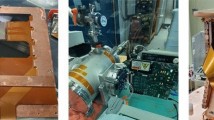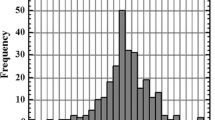Abstract
Transition-edge sensor microcalorimeters have found success as X-ray detectors at synchrotron light-sources, due to a unique combination of high collecting area and good energy resolution. However, the upcoming generation of free-electron lasers (FELs), such as the Linac Coherent Light Source II, is designed to deliver more than \(10^{10}\) photons in a 100 fs pulse at a 100 kHz rate, potentially leading to severe pulse-pileup issues. We will demonstrate that, for most relevant science cases, it is possible to mitigate pulse pile-up using simple X-ray filters in a way that takes advantage of the substantial increase in X-ray flux at modern FELs.



Similar content being viewed by others
Notes
If \(f \tau\) is less than one, there is no risk of pile-up from one pulse to the next. Then, the only pileup problem arises from multiple photons arriving in the same pulse.
Note that re-fluorescence from the beryllium is not problematic, because the beryllium emission line at 100 eV will be blocked by the vacuum window and IR-blocking aluminum, which have a combined transmittance below \(10^{-4}\) at 100 ev.
References
J. Yano, V. Yachandra, Chem. Rev. 114, 4175 (2014). https://doi.org/10.1021/cr4004874
H. Östrom, H. Öberg, H. **n et al., Science 347(6225), 978–981 (2015). https://doi.org/10.1126/science.1260168
M.W. Mara, R.G. Hadt, M.E. Reinhard et al., Science 356(6344), 1276–1280 (2017). https://doi.org/10.1126/science.aam6203
J. Uhlig, W.B. Doriese, J.W. Fowler et al., J. Synchrotron Rad. 22, 766–775 (2015). https://doi.org/10.1107/S1600577515004312
L. Miaja-Avila, G.C. O’Neil, Y.I. Joe et al., Phys. Rev. X 6(3), 31047 (2016). https://doi.org/10.1103/PhysRevX.6.031047
C.J. Titus, M.L. Baker, S.J. Lee et al., J. Chem. Phys. 147, 214201 (2017). https://doi.org/10.1063/1.5000755
D. Li, B.K. Alpert, D.T. Becker et al., J. Low Temp. Phys. 193(5–6), 1287–1297 (2018). https://doi.org/10.1007/s10909-018-2053-6
M. Kubin, J. Kern, S. Gul et al., Struct. Dyn. 4, 54307 (2017). https://doi.org/10.1063/1.4986627
K. Kunnus, I. Rajkovic, S. Schreck et al., Rev. Sci. Instrum. 83, 123109 (2012). https://doi.org/10.1063/1.4772685
K.L. Bren, R. Eisenberg, H.B. Gray, PNAS 112(43), 13123–13127 (2015). https://doi.org/10.1073/pnas.1515704112
A.B. Stickrath, M.W. Mara, J.V. Lockard et al., J. Phys. Chem. B 117(16), 4705–4712 (2013). https://doi.org/10.1021/jp3086705
K.M. Morgan, D.T. Becker, D.A. Bennett et al., IEEE Trans. Appl. Supercond. 29(5), 1–5 (2019). https://doi.org/10.1109/TASC.2019.2903032
J.W. Fowler, B.K. Alpert, W.B. Doriese et al., Astrophys. J. Suppl. Ser. 219(2), 35 (2015). https://doi.org/10.1088/0067-0049/219/2/35
B.L. Henke, E.M. Gullikson, J.C. Davis, Atomic Data and Nuclear Data Tables 54(2), 181-342 (1993). http://henke.lbl.gov/optical_constants/index.html
S.-J. Lee, C.J. Titus, R. Alonso Mori et al., Rev. Sci. Instrum. 90, 113101 (2019). https://doi.org/10.1063/1.5119155
Y.-D. Chuang, Y.-C. Shao, A. Cruz et al., Rev. Sci. Instrum. 88, 13110 (2017). https://doi.org/10.1063/1.4974356
Acknowledgements
This work was supported by the U.S. Department of Energy Office of Basic Energy Sciences proposal No. 100487. The authors would like to thank Leland Gee and Augustin Braun for providing the hemoglobin sample.
Author information
Authors and Affiliations
Corresponding author
Additional information
Publisher's Note
Springer Nature remains neutral with regard to jurisdictional claims in published maps and institutional affiliations.
Rights and permissions
About this article
Cite this article
Titus, C.J., Li, D., Alpert, B.K. et al. Count Rate Optimizations for TES Detectors at a Femtosecond X-ray Laser. J Low Temp Phys 199, 1038–1045 (2020). https://doi.org/10.1007/s10909-020-02379-5
Received:
Accepted:
Published:
Issue Date:
DOI: https://doi.org/10.1007/s10909-020-02379-5




